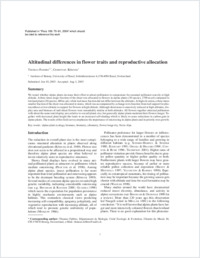Altitudinal differences in flower traits and reproductive allocation
- Fabbro, Thomas Institute of Botany, University of Basel, Switzerland - Ecology and Evolution, Department of Biology, University of Fribourg, Switzerland
- Körner, Christian Institute of Botany, University of Basel, Switzerland
-
18.11.2004
Published in:
- Flora - Morphology, Distribution, Functional Ecology of Plants. - 2004, vol. 199, no. 1, p. 70-81
English
We tested whether alpine plants increase their effort to attract pollinators to compensate for assumed pollinator scarcity at high altitude. A three times larger fraction of the shoot was allocated to flowers in alpine plants (30 species, 2700m asl) compared to lowland plants (20 species, 600m asl), while leaf mass fraction did not differ between the altitudes. At high elevation, a three times smaller fraction of the shoot was allocated to stems, which was accompanied by a change in its function from leaf support for photosynthesis at low altitude to support for flowers at high altitude. Although shoot mass is massively reduced at high altitudes, display area and biomass of individual flowers were remarkably similar at both altitudes. All flowers together attracted pollinators with about the same total display area relative to overall plants size, but generally alpine plants maintain their flowers longer. Together with decreased plant height this leads to an increased self-shading which is likely to cause reductions in carbon gain in alpine plants. The results of this field survey emphasize the importance of outcrossing in alpine plants and its priority over growth.
- Faculty
- Faculté des sciences et de médecine
- Department
- Département de Biologie
- Language
-
- English
- Classification
- Botany
- License
- License undefined
- Identifiers
-
- RERO DOC 5080
- DOI 10.1078/0367-2530-00128
- Persistent URL
- https://folia.unifr.ch/unifr/documents/299907
Statistics
Document views: 168
File downloads:
- 1_farbro_adf.pdf: 411
